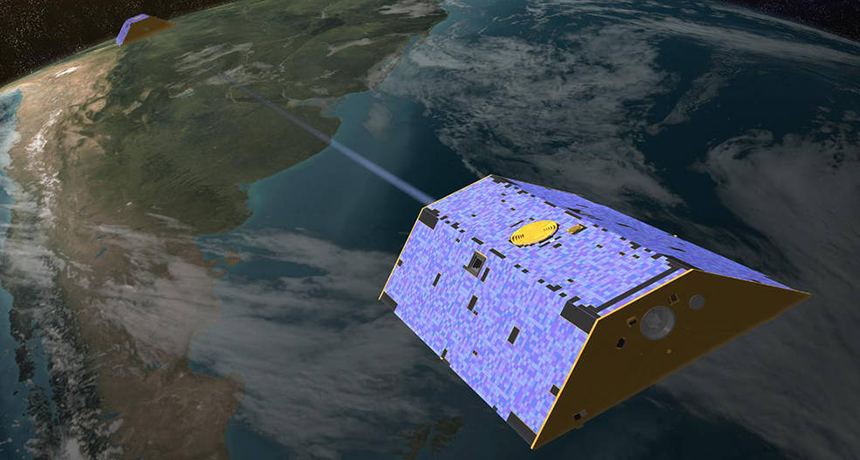Water, water, not everywhere
Satellites show a drop in Earth’s groundwater levels

The U.S.-German Grace satellite can track the movement of water, ice and solid Earth from space.
NASA/JPL-Caltech
Share this:
- Share via email (Opens in new window) Email
- Click to share on Facebook (Opens in new window) Facebook
- Click to share on X (Opens in new window) X
- Click to share on Pinterest (Opens in new window) Pinterest
- Click to share on Reddit (Opens in new window) Reddit
- Share to Google Classroom (Opens in new window) Google Classroom
- Click to print (Opens in new window) Print
Keeping track of water makes for tricky science. It drains through soil, slips through cracks in rocks and refills underwater reserves. It bubbles up through springs and runs in rivers. Water evaporates and forms clouds; rain brings it back to earth, where it keeps plants alive and drains into the soil again.
Scientists who study water’s movements recently reported that levels of groundwater — water found in soil or pooled in underground reservoirs — have been dropping for the last nine years in many places. Part of that decrease is probably due to human activities. People drill wells and pump water from deep underground pools, especially in dry areas, to grow crops and supply drinking water. The new study suggests we’re pumping out too much.
“People are using groundwater faster than it can be naturally recharged,” hydrologist Matthew Rodell told Science News. By recharged, he means faster than rains and snowmelt can replace withdrawn groundwater. When a resource is used faster than it’s replaced, its use is said to be unsustainable. Hydrologists like Rodell, from NASA’s Goddard Space Flight Center in Greenbelt, Md., study the ways water moves around Earth. Sooner or later, at the rates measured by Rodell and his colleagues, the resource could run dry.
The unsustainable groundwater-pumping pattern shows up all around the world, especially in places where agriculture has increased. Scientists detected declining water under the ground in India, southern Argentina, western Australia and some parts of the United States. Hydrologist Jay Famiglietti told Science News that underground water reserves in the world’s driest areas have been severely affected. Famiglietti, who also participated in the new study, works at the University of California Center for Hydrologic Modeling in Irvine.
The scientists’ measurements came from a surprising source: two satellites orbiting Earth. Nicknamed Tom and Jerry after the cartoon cat and mouse, they constantly chase each other around the planet. Instead of teasing and tormenting each other, though, the twin satellites track changes in groundwater by measuring gravity.
Gravity attracts anything with mass — the amount of stuff in something — to anything else with mass. It keeps Earth in orbit around the sun, and the moon in orbit around Earth. Thanks to gravity, people can walk on the ground instead of drifting off into space. Objects with more mass have a stronger gravitational pull on objects around them. The gravitational pull of a solid rock mountain on a satellite flying over it may be different from the ocean’s pull on the spacecraft.
Because of these changes in gravity, Tom and Jerry move farther apart or closer together as they fly over different parts of Earth. The two satellites constantly send signals to each other, keeping track of the distance between them. Like other masses, groundwater’s gravity tugs on the satellites. But as water flows, its mass moves around, changing its gravitational pull.
Tom and Jerry recorded these changes every month for nine years. The satellites, part of a mission called GRACE, began taking measurements in 2002. GRACE stands for Gravity Recovery and Climate Experiment, a collaboration between NASA and the German Aerospace Center.
Recent droughts may explain the drop in groundwater in some places, like Argentina and the southeastern United States. The main reason, however, is farming. To grow crops in places like northern India and the western United States, farmers pump enormous quantities of water from the ground. In the Middle East, farmers use groundwater that probably came from rain that fell thousands of years ago. In this dry area, groundwater isn’t likely to be replaced by more rain any time soon.
Scientists don’t know how serious the falling groundwater levels are. While Tom and Jerry show changes in the amount of water, they don’t show how much total water remains. Some of the reserves may meet water demand for hundreds of years; others might not. Some scientists, like hydrologist Leonard Konikow at the U.S. Geological Survey in Reston, Va., say people need to find ways to manage groundwater more responsibly.
“There are too many areas in the world where groundwater development far exceeds a sustainable level,” he told Science News. “Something will have to change.”
POWER WORDS (adapted from the New Oxford American Dictionary)
hydrology The science concerned with the properties of Earth’s water, especially its movement in relation to land.
gravity The natural force of attraction between any two massive bodies. The greater the mass and the smaller the distance between two objects, the greater the gravitational attraction.
satellite An artificial body placed in orbit around the moon, Earth or another planet in order to collect information or for communication.
mass The amount of matter, or stuff, that something contains.







